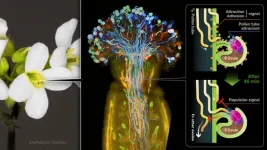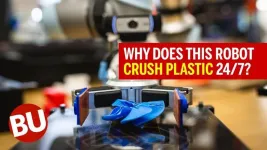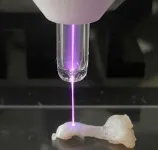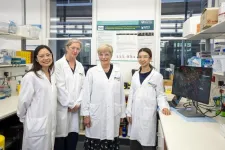(Press-News.org) When cells become tumor cells, their metabolism changes fundamentally. Researchers at the University of Basel and the University Hospital Basel have now demonstrated that this change leaves traces that could provide targets for cancer immunotherapies.
Cancer cells function in turbo mode: Their metabolism is programmed for rapid proliferation, whereby their genetic material is also constantly copied and translated into proteins. As researchers led by Professor Gennaro De Libero from the University of Basel and the University Hospital Basel now report, this turbo metabolism leaves traces on the surface of tumor cells that can be read by specific immune cells. The research team's findings have been published in the journal Science Immunology.
The immunologists working with De Libero discovered the immune cells in question, known as MR1T cells, around ten years ago. This previously unknown type of T cell can attack and eliminate tumor cells. Since then, the team has been researching these cells as a potential tool for novel immunotherapies against a variety of different types of cancer.
Modified DNA and RNA building blocks
The team has now been able to decipher exactly how the T cells recognize the degenerated cells: The altered metabolism of the cancer cells produces a certain type of molecule that appears on the surface of these degenerated cells. “These molecules are chemically modified DNA and RNA building blocks that are the result of changes in three important metabolic pathways,” explains De Libero.
“The fact that cancer cells have a profoundly altered metabolism makes them recognizable to MR1T cells,” adds Dr. Lucia Mori, who was involved in the research. In previous work, the researchers had already discovered that these T cells recognize a surface protein found on all cells, known as MR1. It acts as the proverbial silver platter and presents metabolic products from inside the cell on the cell surface so that the immune system can then check to see whether the cell is healthy or not.
“Several metabolic pathways are altered in cancer cells. This produces particularly suspicious metabolic products and thus alert the MR1T cells,” explains Dr. Alessandro Vacchini, the study's first author.
As a next step, the researchers intend to examine in more detail just how these telltale metabolites interact with the MR1T cells. The long-term vision: Within the framework of future therapies, a patient’s T cells could be reprogrammed and optimized to recognize and attack these cancer-typical molecules.
END
How immune cells recognize the abnormal metabolism of cancer cells
MR1T cells detect cancer through metabolic traces, paving the way for innovative immunotherapies
2024-05-21
ELSE PRESS RELEASES FROM THIS DATE:
How plants mate for life and repel other suitors
2024-05-21
A group of scientists from Nagoya University in Japan has used a specialized microscopic technique to observe the internal reproduction process of the Arabidopsis plant. Their findings, published in EMBO Reports, reveal the mechanism behind a female flower selectively attracting a single male counterpart. These findings provide insights that may help optimize seed production and improve agricultural breeding practices.
Angiosperms, commonly referred to as flowering plants, have male and female reproductive organs. In the process of plant reproduction, when a pollen grain that ...
3D printing robot uses AI machine learning for US Army research
2024-05-21
Inside a lab in Boston University’s College of Engineering, a robot arm drops small, plastic objects into a box placed perfectly on the floor to catch them as they fall. One by one, these tiny structures—feather-light, cylindrical pieces, no bigger than an inch tall—fill the box. Some are red, others blue, purple, green, or black.
Each object is the result of an experiment in robot autonomy. On its own, learning as it goes, the robot is searching for, and trying to make, an object with the most efficient ...
Ruptured Achilles tendon shows faster repair amid plasma irradiation treatment
2024-05-21
What is the largest ligament in the human body? It might surprise some people that it is the Achilles tendon. Even though it is also considered the toughest ligament, the Achilles tendon can rupture, with many such injuries involving sports enthusiasts in their 30s or 40s. Surgery might be required, and a prolonged period of rest, immobilization, and treatment can be difficult to endure.
Seeking to shorten the recovery time, a research team led by Osaka Metropolitan University Graduate School of Medicine’s Katsumasa Nakazawa, a graduate student in the Department of Orthopedic Surgery, Associate Professor ...
Screen time not the main factor making parent-child interactions worse, study finds
2024-05-21
Technology use is at an all-time high and understanding how this impacts daily life is crucial. When it comes to parent-child interactions, scientists have coined the term ‘technoference,’ meaning technology interference. It occurs when parent-child interaction and communication are disrupted by the use of digital devices.
But is distraction caused by digital devices more detrimental to parent-child interaction than when parental distraction comes from different sources? Researchers in Switzerland have investigated.
“In this study, we show that ...
Improving the effectiveness of earthquake early warning systems
2024-05-21
Mobile phones have become invaluable for receiving emergency alerts such as weather warnings, evacuation notices and notifications about missing persons. In Japan, where earthquakes are frequent, they are vital for delivering earthquake warnings and advising people to take protective actions beforehand. To deal with such situations promptly, the Earthquake Early Warning (EEW) system sends out notifications to areas expected to experience strong tremors by detecting primary seismic waves (P-waves) that arrive before the secondary waves (S-waves). However, the short time between receiving the notification and the arrival of S-waves ...
Addressing homelessness in older people
2024-05-21
Homelessness doesn’t only happen to young people but also affects older adults in growing numbers, write authors in an analysis in CMAJ (Canadian Medical Association Journal) that describes this emerging crisishttps://www.cmaj.ca/lookup/doi/10.1503/cmaj.231493.
People experiencing homelessness are considered older adults at age 50, as visible aging is often evident at younger ages in individuals experiencing homelessness compared with individuals who have secure housing. Individuals experiencing homelessness often develop chronic ...
One in 5 adults in Canada without access to primary care
2024-05-21
More than 1 in 5 adults in Canada did not have access to primary care, with large regional gaps in access, found new research in CMAJ (Canadian Medical Association Journal) https://www.cmaj.ca/lookup/doi/10.1503/cmaj.231372.
“Translated to the population of Canada, our survey estimates that more than 6.5 million adults across the country don’t have access to a family doctor or nurse practitioner they can see regularly,” says Dr. Tara Kiran, a family physician and researcher at the MAP Centre for Urban Health Solutions at St. Michael’s Hospital, Unity Health Toronto and the University ...
Studies on risks of weight-loss drugs and more presented at Digestive Disease Week
2024-05-21
Washington (May 14, 2024) — Studies examining the risks of GLP-1 weight-loss drugs, distinguishing alpha-gal syndrome from other GI disorders, and comparing medications to slow the progression of liver disease in patients with alcohol-use disorder will be presented this week at Digestive Disease Week (DDW) 2024. Abstracts are available to registered media. Embargos lift at 12:01 a.m. EDT on the day they are presented.
Here are summaries of the new research:
Re-examining the risks of gastrointestinal adverse events associated with glucagon-like peptide-1 receptor agonists for weight loss with more stringent criteria on a comprehensive ...
Pancreatic cancer research receives $8m philanthropic funding boost
2024-05-21
An exceptional $8 million, 10-year philanthropic investment will spearhead new treatments for pancreatic cancer and create a new dedicated research centre at WEHI.
The centre, to be established thanks to an investment by Australian business leader and WEHI President Jane Hemstritch AO, aims to help close the significant survival gap between pancreatic cancer and other cancers.
The Hemstritch Centre of Excellence for Pancreatic Cancer Research will provide a leading team of scientists and clinicians with long-term funding to ask big research questions. They aim to make major ...
'Hunting for treasures' with AI: Astronomers detect rare neutral atomic-carbon absorbers with deep neural network
2024-05-21
Recently, an international team led by Prof. GE Jian from the Shanghai Astronomical Observatory of the Chinese Academy of Sciences conducted a search for rare weak signals in quasar spectral data released by the Sloan Digital Sky Survey III (SDSS-III) program using deep learning neural networks. By introducing a new method to explore galaxy formation and evolution, the team showcased the potential of artificial intelligence (AI) in identifying rare weak signals in astronomical big data. This study was published ...
LAST 30 PRESS RELEASES:
Maternal nativity, race, and ethnicity and infant mortality in the US
Migration-related trauma among asylum seekers exposed to the migrant protection protocols
Jupiter’s moon Europa has a seafloor that may be quiet and lifeless
SwRI upgrades nuclear magnetic resonance laboratory for pharmaceutical R&D
House sparrows in northern Norway can help us save other endangered animals
Crohn's & Colitis Foundation survey reveals more than 1/3 of young adults with IBD face step therapy insurance barriers
Tethered UAV autonomous knotting on environmental structures for transport
Decentralized social media platforms unlock authentic consumer feedback
American Pediatric Society announces Vanderbilt University School of Medicine as host institution for APS Howland Visiting Professor Program
Scientists discover first method to safely back up quantum information
A role for orange pigments in birds and human redheads
Pathways to net-zero greenhouse gas emissions for Southeast Asia
A JBNU–KIMS collaborative study on a cost-effective alloy matches superalloys for power plants and energy infrastructure
New study overturns long-held model of how plants coordinate immune responses.
New AI model predicts disease risk while you sleep
Scientists discover molecular ‘reshuffle’ and crack an 80-year-old conundrum
How stressors during pregnancy impact the developing fetal brain
Electrons lag behind the nucleus
From fungi to brain cells: one scientist's winding path reveals how epigenomics shapes neural destiny
Schizophrenia and osteoporosis share 195 genetic loci, highlighting unexpected biological bridges between brain and bone
Schizophrenia-linked genetic variant renders key brain receptor completely unresponsive to both natural and therapeutic compounds
Innovative review reveals overlooked complexity in cellular energy sensor's dual roles in Alzheimer's disease
Autism research reframed: Why heterogeneity is the data, not the noise
Brazil's genetic treasure trove: supercentenarians reveal secrets of extreme human longevity
The (metabolic) cost of life
CFRI special issue call for papers: New Frontiers in Sustainable Finance
HKU Engineering scholar demonstrates the smallest all-printed infrared photodetectors to date
Precision empowerment for brain "eavesdropping": CAS team develops triple-electrode integrated functional electrode for simultaneous monitoring of neural signals and chemical transmitters during sleep
Single-capillary endothelial dysfunction resolved by optoacoustic mesoscopy
HKU three research projects named among ‘Top 10 Innovation & Technology News in Hong Kong 2025’ showcasing excellence in research and technology transfer
[Press-News.org] How immune cells recognize the abnormal metabolism of cancer cellsMR1T cells detect cancer through metabolic traces, paving the way for innovative immunotherapies





